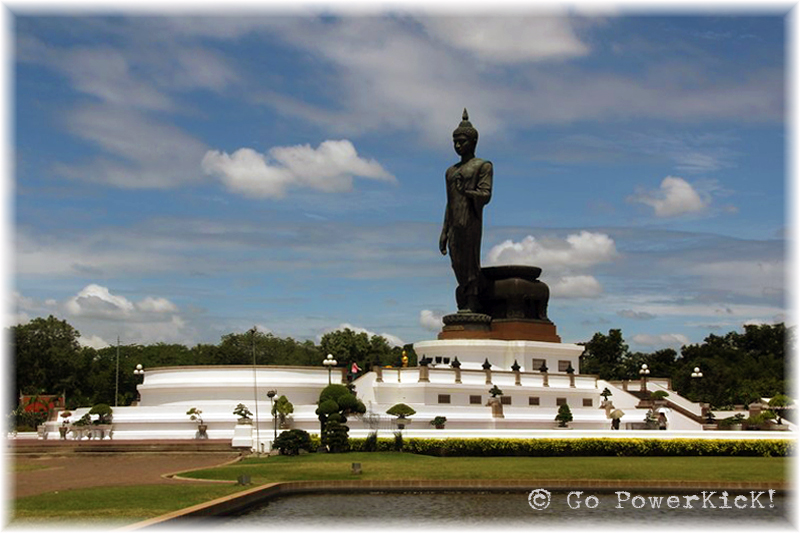Defying the forecasted thunderstorms, I hopped on my motorcycle and made the 40km ride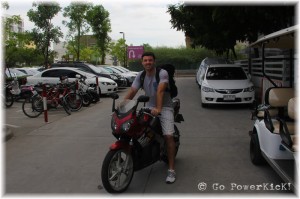 west of Bangkok to Puttamonthon Park. I tried to get an early start so, in case the weather forecast turned out to be correct, I would miss and potential storms. The morning traffic was ‘light’ which was a nice change of pace and the cool morning air made the ride even more enjoyable. I buzzed passed the zoo and parliament buildings as I headed over the Chao Phraya River and rode out of the city. Construction of the park, commissioned by HM King Bhumibol Adulyadej, began in 1957. This happened to be a significant year in Buddhist culture because it commemorated the 2,500th year of Buddhism. After 21 years of construction the park was finally complete and now is an oasis of peace.
west of Bangkok to Puttamonthon Park. I tried to get an early start so, in case the weather forecast turned out to be correct, I would miss and potential storms. The morning traffic was ‘light’ which was a nice change of pace and the cool morning air made the ride even more enjoyable. I buzzed passed the zoo and parliament buildings as I headed over the Chao Phraya River and rode out of the city. Construction of the park, commissioned by HM King Bhumibol Adulyadej, began in 1957. This happened to be a significant year in Buddhist culture because it commemorated the 2,500th year of Buddhism. After 21 years of construction the park was finally complete and now is an oasis of peace.
After about an hour on the bike I pulled up to the entrance of the park. The view from the 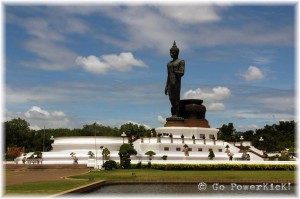 street sheds little light on what actually lies inside. Once inside, and riding along the winding road, signs pointed out the many exhibits and areas the park has to offer: meditation halls, a bamboo forest, a mango orchard and a Buddhist museum. I found my way to the heart of the park, parked my bike and began to admire what I had come to see. Facing east and standing 52ft tall is an enormous Buddha image made of bronze. The prominent stature dwarfs its surroundings and completely captures your attention. Surrounding the Buddha and nestled amongst green lawns, a small river and a canopy of trees are four monuments symbolizing the main events in the life of the Buddha.
street sheds little light on what actually lies inside. Once inside, and riding along the winding road, signs pointed out the many exhibits and areas the park has to offer: meditation halls, a bamboo forest, a mango orchard and a Buddhist museum. I found my way to the heart of the park, parked my bike and began to admire what I had come to see. Facing east and standing 52ft tall is an enormous Buddha image made of bronze. The prominent stature dwarfs its surroundings and completely captures your attention. Surrounding the Buddha and nestled amongst green lawns, a small river and a canopy of trees are four monuments symbolizing the main events in the life of the Buddha.
The first monument is the Birth of the Buddha. Buddhists believe that immediately after his birth the Buddha walked seven steps on lotus flowers. Here, seven stones are placed in a circle and each is carved in the shape of a lotus blossom. Also carved on top of each stone is a footprint signifying a step taken by the Buddha.
 Second is the monument to Enlightenment of the Buddha. It is said Buddha reached Enlightenment while meditating under a Bodhi Tree. A tree has been planted here symbolizing Enlightenment. The tree is wrapped with sashes to show reverence as well as respect. A quote by the Buddha which says “to worship the tree is the same as you worship me” really captures the significance.
Second is the monument to Enlightenment of the Buddha. It is said Buddha reached Enlightenment while meditating under a Bodhi Tree. A tree has been planted here symbolizing Enlightenment. The tree is wrapped with sashes to show reverence as well as respect. A quote by the Buddha which says “to worship the tree is the same as you worship me” really captures the significance.
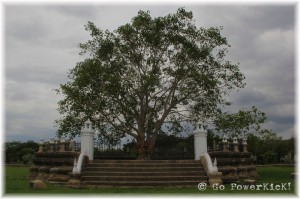 The third monument is to the Teaching of the Buddha. Here a Wheel of the Buddha stands with five seats seated before it, referring to the first sermon of the Buddha. The five seats represent the first five monks of Buddhism.
The third monument is to the Teaching of the Buddha. Here a Wheel of the Buddha stands with five seats seated before it, referring to the first sermon of the Buddha. The five seats represent the first five monks of Buddhism.
 The last is Nirvana. A replica of the Buddha’s bed is shown here to represent entering Nirvana. On the bed are carved patterns of leaves which look as if they have fallen from above.
The last is Nirvana. A replica of the Buddha’s bed is shown here to represent entering Nirvana. On the bed are carved patterns of leaves which look as if they have fallen from above.
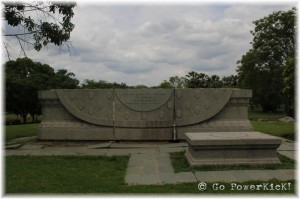 Built on the bank of a lake in the park is the Temple of Marble Pali Canon, also called the Wiharn. Here 1,418 marble slabs, intricately carved with golden Thai characters, detail the sacred scriptures of Buddhism. Lining the walls, just below the ceiling, paintings depict different scenes of Buddhist faith. The style is an ancient Buddhist art reminiscent of what can be found in older Temples throughout the country. There are easily a hundred or more paintings along
Built on the bank of a lake in the park is the Temple of Marble Pali Canon, also called the Wiharn. Here 1,418 marble slabs, intricately carved with golden Thai characters, detail the sacred scriptures of Buddhism. Lining the walls, just below the ceiling, paintings depict different scenes of Buddhist faith. The style is an ancient Buddhist art reminiscent of what can be found in older Temples throughout the country. There are easily a hundred or more paintings along 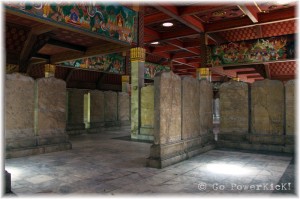 the walls and losing track of time while walking through observing and enjoying these works of art is not uncommon.
the walls and losing track of time while walking through observing and enjoying these works of art is not uncommon.
The Park hasn’t made its way onto many of the popular tourists routes yet. In fact, while I was there I was the only non-Thai I saw exploring the grounds. Regardless, it’s a perfect place to go if you’re looking for a peaceful place to escape and relax for a day. There’s a rather good chance you may have the place all to yourself, unless you visit during a Buddhist Festival.
Comments
More Good Reads!

Helicopter Over Oahu
May 10, 2014
May 2014 PowerKicK Of The Month
May 01, 2014
Bike The Golden Gate Bridge
April 29, 2014
Hua Hin Hills Vineyard
April 19, 2014
Songkran in Nan
April 10, 2014
April 2014 PowerKicK Of The Month
April 01, 2014
Mae Hong Son Motorcycle Loop: Mae Sot to Mae Hong Son
March 28, 2014
Becoming A Buddhist Monk In Thailand
March 20, 2014






